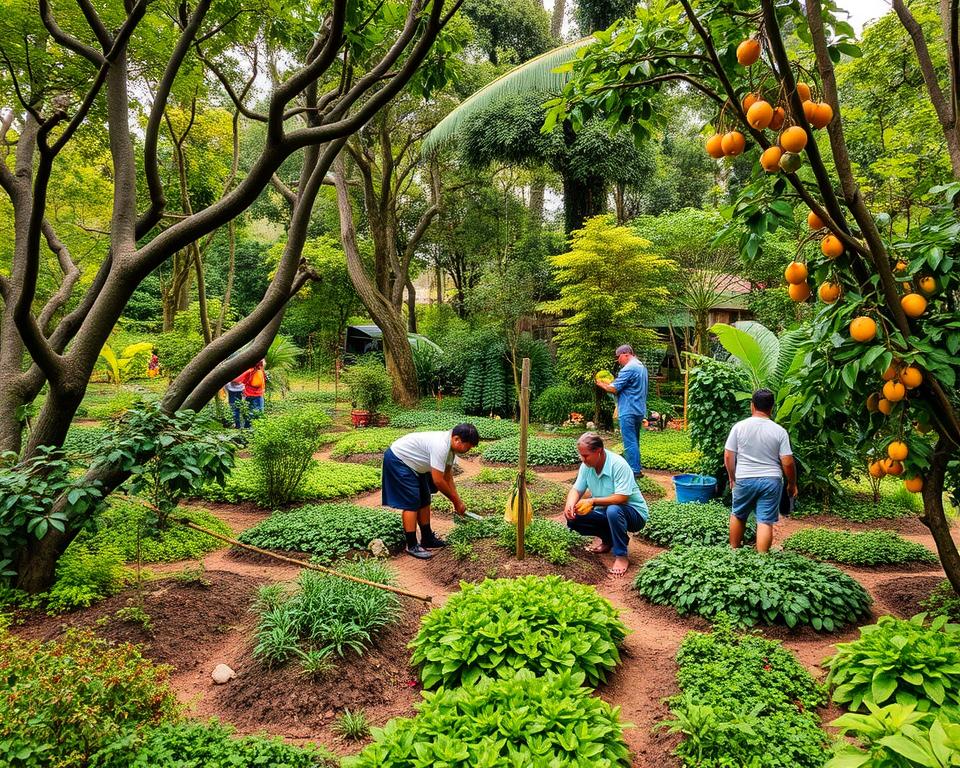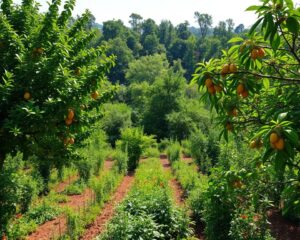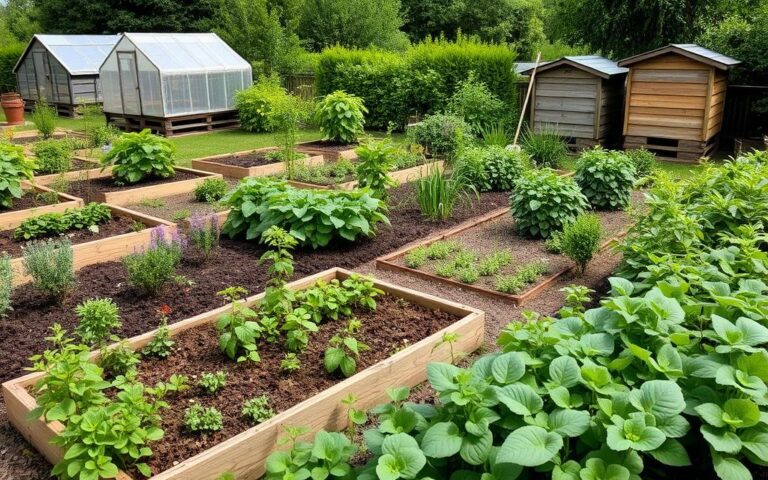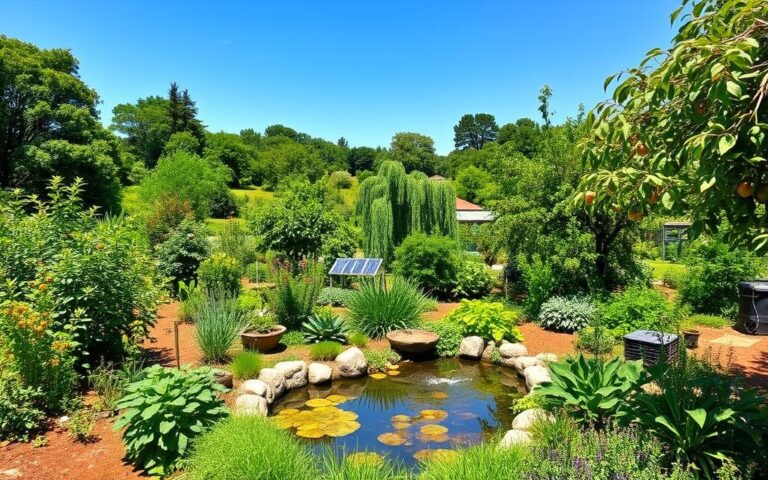Did you know the global food system is responsible for a third of greenhouse gas emissions? This is a harsh reality that shows we need sustainable farming practices now more than ever. With the world’s population expected to hit nearly 10 billion by 2050, our food systems face huge challenges. Traditional farming often harms soil health, making food forests a vital alternative within regenerative agriculture.
Food forests are a balanced solution for sustainable agriculture and ecosystem restoration. They mimic natural ecosystems, offering diverse food sources and sequestering carbon. They also manage water better and boost biodiversity. By working on food forest projects, communities connect more with nature and become more resilient to climate change.
Understanding Sustainable Agriculture
Sustainable Agriculture helps farms meet today’s needs without harming tomorrow’s resources. It focuses on keeping the environment healthy while making farming profitable and fair for everyone. It’s key to making farming more thoughtful and responsible.
Definition and Importance
Sustainable agriculture is about farming in a way that keeps ecosystems healthy. It provides food and resources for people. It’s important for many reasons:
- Resource Conservation: It uses natural resources wisely, protecting soil, water, and wildlife.
- Economic Viability: It helps farmers make money without harming the land or resources.
- Community Impact: It brings people together by making food more accessible and fair.
Key Principles of Sustainability
There are key principles for Sustainable Agriculture:
- Crop Diversity: Using different crops together to improve soil health and fight pests.
- Cover Crops and Perennials: Planting these helps prevent soil erosion and adds nutrients.
- Tillage Reduction: Using no-till methods reduces soil damage and erosion.
- Integrated Pest Management (IPM): Using natural methods to control pests cuts down on chemicals.
- Livestock and Crop Integration: Combining animals and crops makes farming more efficient and profitable.
- Agroforestry: Adding trees to farms provides extra benefits like protecting crops and creating income.
- Whole Systems and Landscapes Management: Treating all parts of the farm as important for sustainability.
Benefits for the Environment
Sustainable agriculture has many benefits for the environment. For example:
| Practice | Environmental Benefit |
|---|---|
| Crop Diversity | Improves soil health and pest control. |
| Cover Crops | Prevents erosion and enriches soil nutrients. |
| No-Till Farming | Reduces erosion and improves soil structure. |
| Integrated Pest Management | Uses fewer harmful chemicals. |
| Soil Health Focus | Helps retain water and prevent pollution. |
| Drought-Resistant Systems | Makes farms more resilient to water shortages. |
Introduction to Food Forests
Food forests are a new way to grow food that’s good for the planet. They look like real forests but have edible plants at different heights. This setup makes them easy to take care of and helps the environment.
What Are Food Forests?
Food forests, also known as forest gardens, are special places where many edible plants grow together. They aim to copy the natural balance of a forest. This way, you can grow your own food, use less chemicals, and help the environment.
Different Types of Food Forests
There are many kinds of food forests, each for different places and needs:
- Urban Food Forests: These are in cities and use small spaces to grow lots of food.
- Community Projects: Groups work together to build and care for these gardens, bringing people closer.
- Traditional Agroforestry Systems: These mix food forests with farming to make food production more sustainable.
Historical Significance
Food forests have a long history, starting with ancient cultures. They were key for food and health. Today, as the world’s population grows, food forests are a smart way to farm. They help us grow food in a way that’s good for the planet and fights climate change.
| Type of Food Forest | Description | Potential Benefits |
|---|---|---|
| Urban Food Forests | Utilize limited urban spaces for diverse edible plants | Enhances local food access, promotes community involvement |
| Community Projects | Collaborative efforts that engage local populations in creation and maintenance | Strengthens neighborhood ties, encourages shared food production |
| Traditional Agroforestry Systems | Integrates diverse plantings in agricultural systems for sustainable practices | Supports biodiversity, improves soil health, and provides food security |
The Benefits of Integrating Food Forests
Adding food forests to your community brings many benefits. They help the environment and bring people together. These systems improve biodiversity, soil health, and make communities more resilient to climate change.
Enhancing Biodiversity
Community food forests are key to boosting biodiversity. They create homes for many plants and animals. This variety supports a stable ecosystem and builds community pride.
People often get involved in caring for these spaces. This makes them feel connected to their community.
Improving Soil Health
Good soil is essential for healthy landscapes. Food forests help improve soil quality naturally. They fix nitrogen without synthetic fertilizers.
Their layered design also reduces soil damage. This approach supports long-term soil health and productivity.
Increasing Resilience to Climate Change
Food forests are crucial for fighting climate change. They offer a variety of food that can handle changing weather. This helps communities keep food supplies stable.
By storing carbon, these forests help reduce climate change. Communities with food forests are more ready for extreme weather. This supports local food security and environmental health.
How Food Forests Support Regenerative Practices
Food forests are key in regenerative practices. They help ecosystems heal and improve nutrient cycling. By adding many plant species to farms, they fix damaged habitats. This makes ecosystems strong and less dependent on outside help.
Exploring food forests shows their role in keeping nature balanced and resilient.
Regeneration of Ecosystems
Food forests help ecosystems heal. They bring back biodiversity and stop soil erosion. In big farms, soil erosion is much worse than in nature.
With different plants at each level, food forests create homes for many animals. This supports natural balance and health.
Enhancing Nutrient Cycling
Nutrient cycling is vital in food forests. They keep soil healthy and fertile, without needing synthetic fertilizers. Plants work together to recycle nutrients, keeping the ecosystem balanced.
This approach cuts down on water pollution. It helps prevent harmful algal blooms caused by big farms. Food forests do more than grow food; they care for our ecosystem’s base.
| Benefit | Food Forests | Industrial Agriculture |
|---|---|---|
| Soil Erosion | Low erosion rates | 10 to 100 times higher than soil formation |
| Nutrient Cycling | Natural cycling, less synthetic inputs | Increased reliance on chemical fertilizers |
| Biodiversity | High diversity, multiple layers of vegetation | Monocultures |
| Water Pollution | Reduced chemical runoff | Contributes to harmful algal blooms |
Designing a Food Forest
Creating a food forest is a rewarding experience. It lets you build a diverse ecosystem with edible plants. Knowing the key components helps your food forest thrive for years.
Essential Components for Growth
Designing a food forest starts with understanding its layers. It has seven layers: canopy, sub-canopy, shrub, herbaceous, ground cover, vine, and root. This structure boosts biodiversity and promotes natural coexistence.
Choosing the Right Plants
Choosing plants is crucial. Pick species that fit your local climate and work well together. Canopy trees provide shade and store carbon. Shrubs like blueberries and elderberries produce food at lower heights.
Herbaceous plants, such as asparagus or thyme, increase productivity. Native species strengthen the root network, protect soil, and reduce fertilizer needs.
Planning for Success
Planning is key for a successful food forest. Start with a layout that considers plant sizes and growth habits. Think about seasonal changes when planting.
Plant trees and shrubs in fall, and smaller plants in spring or fall. Sheet mulching can prepare the soil for planting, ensuring a healthy start.
| Layer | Examples of Plants | Benefits |
|---|---|---|
| Canopy Layer | Maple, Oak, Walnut | Provides shade, carbon storage |
| Sub-Canopy Layer | Serviceberry, Cherry | Encourages fruit production |
| Shrub Layer | Blueberries, Elderberries | Offers edible berries |
| Herbaceous Layer | Basil, Garlic, Thyme | Enhances soil health, attracts pollinators |
| Ground Cover Layer | Strawberries, Creeping Thyme | Prevents erosion, suppresses weeds |
| Vine Layer | Grapes, Beans | Maximizes vertical space |
| Root Layer | Carrots, Potatoes | Stabilizes soil, improves nutrient cycling |
Maintenance Practices for Food Forests
Maintaining a food forest is less work than traditional farming. Yet, it still needs regular care to stay healthy and productive. Seasonal maintenance keeps the ecosystem thriving and tackles common challenges.
Seasonal Care Tips
Each season has its own care needs for a food forest. Here are some tips for each season:
- Spring: Prune to promote healthy growth and remove dead or diseased plants.
- Summer: Mulch to keep moisture in and weeds out, and watch for pests.
- Autumn: Pick fruits and nuts, and plant cover crops to enrich the soil in winter.
- Winter: Check on plant health and plan for the next growing season.
Addressing Common Challenges
Despite good care, food forests face challenges. Here’s how to tackle them:
- Invasive species: Keep an eye out and remove invasive plants to protect native species and biodiversity.
- Pest outbreaks: Use integrated pest management (IPM) with natural predators like ladybugs and encourage biodiversity.
- Soil health issues: Test the soil often and adjust it as needed for your plants’ health.
By following these tips, your food forest will be more resilient. It will thrive for years, offering many benefits of maintaining a food forest.
| Season | Maintenance Activity | Importance |
|---|---|---|
| Spring | Pruning | Encourages healthy growth and removes diseased branches. |
| Summer | Mulching | Helps retain moisture and limits weed growth. |
| Autumn | Harvesting | Gathers produce and allows for cover cropping. |
| Winter | Assessment | Evaluates plant health and prepares plans for next seasons. |
Case Studies: Successful Food Forest Projects
Looking at food forest projects in the United States shows how they help local communities. Each project uses different methods and shows how important community involvement is. They show how food forests can change both cities and countryside.
Examples from the United States
The Boston Food Forest Coalition has made big progress in Boston. They aim to have 30 food forests by 2030 and have already set up 10. Their forests have many different plants:
- Overstory Tree Layer: American chestnut, black cherry, black walnut, Chinquapin oak, Chinese chestnut, pecan, red mulberry, persimmon
- Understory Tree Layer: Apple, apricot, black chokeberry, crabapple, elderberry, fig, nannyberry, peach, pear, serviceberry, pea-shrub, sumac, sweet cherry, sour cherry, witch hazel, pawpaw
- Shrub Layer: Gooseberry, blackberry, blueberry, sage, bayberry, raspberry, sea buckthorn
- Herbaceous Crop Layer: Calendula, asparagus, comfrey, mullein, yarrow, dill, echinacea, evening primrose, zucchini, goldenrod, kale, lambsquarters, lemon balm, Swiss chard
- Groundcover Layer: Mint, nasturtium, purslane, strawberry, thyme
- Root Crop Layer: Turnip, garlic, onion, beet, carrot, radish
- Vine Crop Layer: Grape, kiwi, maypop, sugar snap pea, heirloom tomato
- Fungal Layer: Shiitake mushrooms
In the Southeast, the Grow Enrichment project at Two Rivers Park in Nashville, Tennessee, covers 14 acres. It shows how to successfully create a food forest. This park is a model for using sustainable practices in urban areas.
Lessons Learned from Practitioners
Practitioners share key lessons for successful food forest projects:
- Community Involvement: Getting locals involved helps care for the forest.
- Diverse Species Selection: Using many plants makes the forest diverse and strong.
- Continuous Education: Training volunteers and participants is crucial for management.
- Long-term Vision: Planning for the future ensures the forest’s success.
Challenges like funding and volunteer reliance offer insights for future projects. Knowing these helps make food forest projects work.
| Project | Location | Size | Established | Goals |
|---|---|---|---|---|
| Boston Food Forest Coalition | Boston, Massachusetts | Varied | 2012 | 30 food forests by 2030 |
| Grow Enrichment | Nashville, Tennessee | 14 acres | 2019 | Sustainable urban food systems |
Getting Involved with Food Forests
If you want to help the planet, food forests are a great place to start. You can start your own project or join local efforts. There are many ways to get involved.
Starting Your Own Project
First, find a good spot for your food forest. Look for places with the right soil, sunlight, and water. Talking to local gardeners can help you learn the best practices.
Joining Local Initiatives
Joining local groups can make a big difference. Many places have groups focused on food forests. You can work with schools, non-profits, or community gardens. This way, you learn from others and help your community.
Resources for Continued Learning
There are many ways to keep learning about food forests. Online courses and workshops offer hands-on learning. Books and webinars by experts can also help you grow your knowledge.

| Resource Type | Examples | Benefits |
|---|---|---|
| Online Courses | Permaculture Design Course, Food Forest Foundations | Self-paced learning, diverse topics |
| Community Workshops | Local Gardening Clubs, Non-profit Organizations | Hands-on experience, networking opportunities |
| Books | The Edible Forest Garden, Gaia’s Garden | In-depth knowledge, practical tips |
| Webinars | Experts from Agricultural Universities | Access to cutting-edge research, Q&A sessions |
Getting involved in food forests is a step towards a greener future. It’s a journey of learning and making a difference together.
The Future of Food Forests in Sustainable Agriculture
Looking ahead, food forests are becoming key in sustainable farming. We’ll see more urban food forests, using small spaces for big benefits. Also, permaculture will become more common, boosting biodiversity. Governments will likely support these efforts, helping our planet and food systems.
These trends show how food forests fit into solving environmental problems. They offer new ways to farm sustainably.
Trends to Watch
By 2050, we’ll need more food than ever. Food forests can help a lot. They make food systems stronger by offering diverse food sources and connecting communities with local farms.
Food forests also fight deforestation and soil loss. These are big problems as farming expands. Joining these efforts can help make our future greener.
The Potential Impact on Food Security
Food forests can reduce waste and make food systems more resilient. With 80% of the world’s population relying on imported food, local efforts are crucial. They help balance food distribution.
By using space efficiently and boosting biodiversity, food forests are productive and green. Supporting this movement can change how we farm and eat.




